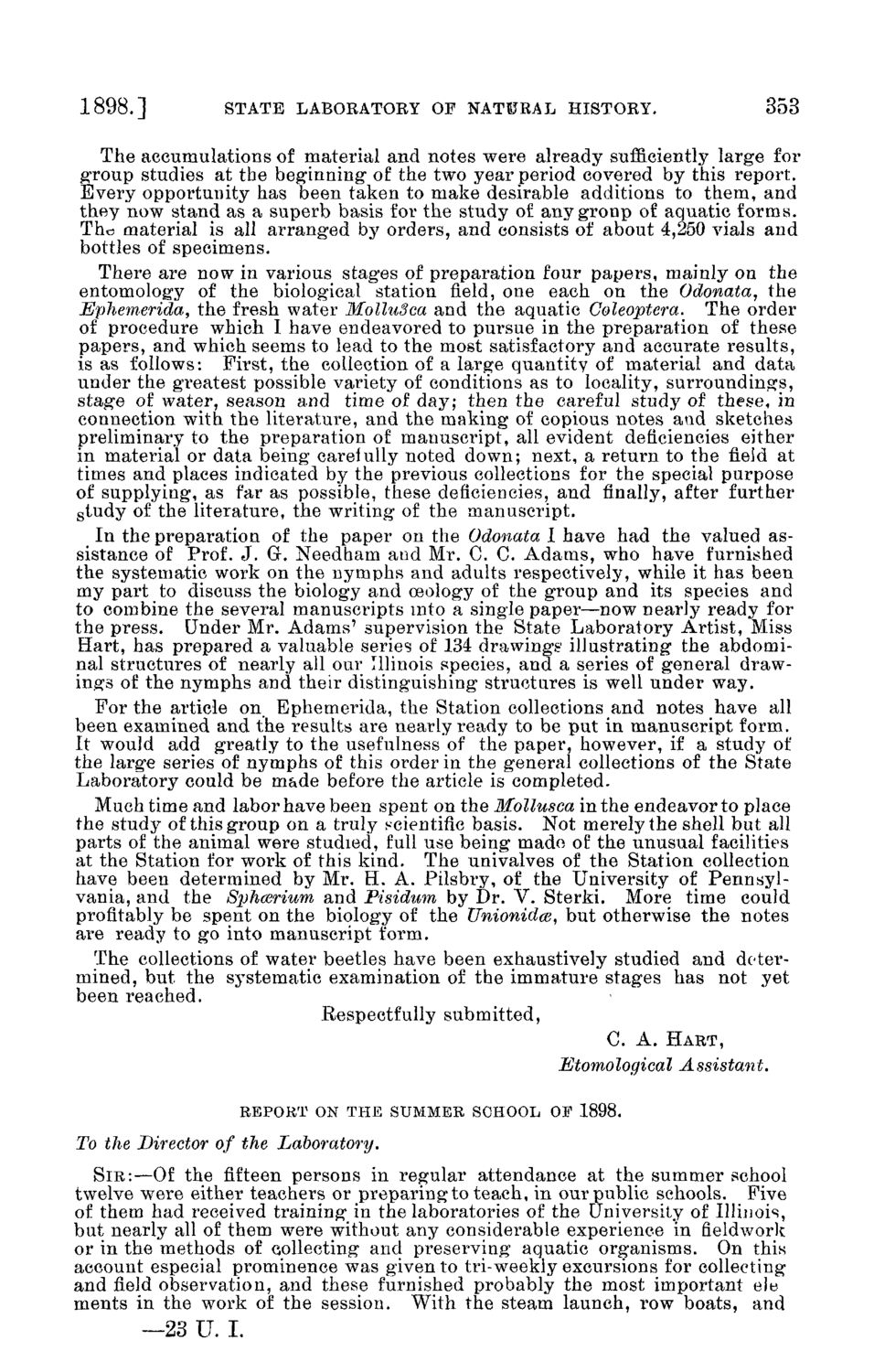| |
| |
Caption: Board of Trustees Minutes - 1898
This is a reduced-resolution page image for fast online browsing.

EXTRACTED TEXT FROM PAGE:
1898.] STATE LABORATORY OF NATURAL HISTORY. 353 The accumulations of material and notes were already sufficiently large for group studies at the beginning* of the two year period covered by this report. Every opportunity has been taken to make desirable additions to them, and they now stand as a superb basis for the study of any group of aquatic forms. Tho material is all arranged by orders, and consists of about 4,250 vials and bottles of specimens. There are now in various stages of preparation four papers, mainly on the entomology of the biological station field, one each on the Odonata, the JEphemerida, the fresh water MolluSca and the aquatic Coleoptera. The order of procedure which I have endeavored to pursue in the preparation of these papers, and which seems to lead to the most satisfactory and accurate results, is as follows: First, the collection of a large quantity of material and data under the greatest possible variety of conditions as to locality, surroundings, stage of water, season and time of day; then the careful study of these, in connection with the literature, and the making of copious notes and sketches preliminary to the preparation of manuscript, all evident deficiencies either in material or data being careiully noted down; next, a return to the field at times and places indicated by the previous collections for the special purpose of supplying, as far as possible, these deficiencies, and finally, after further s tudy of the literature, the writing of the manuscript. In the preparation of the paper on the Odonata I have had the valued assistance of Prof. J. G. Needham and Mr. C. C. Adams, who have furnished the systematic work on the nymphs and adults respectively, while it has been my part to discuss the biology and oeology of the group and its species and to combine the several manuscripts into a single paper—now nearly ready for the press. Under Mr. Adams' supervision the State Laboratory Artist, Miss Hart, has prepared a valuable series of 134 drawings illustrating the abdominal structures of nearly all our Illinois species, and a series of general drawings of the nymphs and their distinguishing structures is well under way. For the article on Ephemerida, the Station collections and notes have all been examined and the results are nearly ready to be put in manuscript form. It would add greatly to the usefulness of the paper, however, if a study of the large series of nymphs of this order in the general collections of the State Laboratory could be made before the article is completed. Much time and labor have been spent on the Mollusca in the endeavor to place the study of this group on a truly scientific basis. Not merely the shell but all parts of the animal were studied, full use being made of: the unusual facilities at the Station for work of this kind. The univalves of the Station collection have been determined by Mr. H. A. Pilsbry, of the University of Pennsylvania, and the Sphcerium and Pisidum by Dr. V. Sterki. More time could profitably be spent on the biology of the Unionidce, but otherwise the notes are ready to go into manuscript form. The collections of water beetles have been exhaustively studied and determined, but the systematic examination of the immature stages has not yet been reached. Respectfully submitted, C. A. H A R T , Etomological REPORT ON THE SUMMER SCHOOL OF 1898. Assistant. To the Director of the Laboratory. SIR:—Of the fifteen persons in regular attendance at the summer school twelve were either teachers or preparing to teach, in our public schools. Five of them had received training in the laboratories of the University of Illinois, but nearly all of them were without any considerable experience in fieldwork or in the methods of collecting and preserving aquatic organisms. On this account especial prominence was given to tri-weekly excursions for collecting and field observation, and these furnished probably the most important ele ments in the work of the session. With the steam launch, row boats, and —23 U. I.
| |